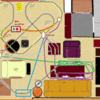RRRR John
I will try to explain the construction of two train operation on a loop.
My layout is conventional control and I use relay operated isolated sections of track to control two of my three loops to operate two trains per loop. This has been in operation since 1977 when the layout was built in Kingston, Jamaica. To show how this works see youtube video below which shows two train operation on the outer loop only.
https://www.youtube.com/watch?v=szGr4ymfJEs
I used the Lionel Book referenced earlier as “Lionel Train and Accessory Manuel” 1954 but a later addition called “Lionel Train and Accessory Manuel “Copyrighted in 1975 but it is the same.
Page 35 of the 1954 ed shows the circuit. I use a 12 vac relay with signal pole double throw contacts (good for at least 10 amps) and only use one set of contacts. The relays are triggered by a single section of isolated track on one outside rail with the train wheels making contact with isolated track and the common outside rail on the other side of the section (see pg 37 of 1954 ed).
I installed a feed from the transformers variable voltage output to isolated 5 or 6 section of track, where the train stops, with 5 ohm, 25 watt adjustable resistor to allow a couple of volts to go to the section to keep the e units from cycling (see pg 31 of the 1954 ed).
To allow trains to operate in both directions in the loop I have two isolate 5 to 6 sections, one on each side of the trigger sections where the relay gets it signal. I select the direction with a single pole double throw slide switch that lets me select which isolated 5 or 6 section will be controlled and thus the direction. (Note the trigger section must always be ahead of the isolated section).
I also have single throw switch in the 12 vac line to the relay of each loop to turn off the relay when not in operation. The relay reverts to send power to the 5 or 6 isolated section when power is off of the relay.
Hope this helps. Two train operation is lots of fun but you must keep the trains somewhat balanced as to operating voltage so that a lighter train can not over run a slower one before it reaches the trigger section!

Picture showing control panel switches for Two Train Operation per loop switches. In and Out refer to inner loop system and outer loop system.
Top Red reset button on LW trans circuit breaker with red light tripped indicator to right of button.
1 trans and 2 trans switch allows red light LW to run whole board, or when to 2 trans to allow red light LW to run main board inside loop only. And Green lighted LW to run main outside loop and all of new board.
Charlie













